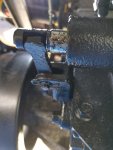Pressure gauges usually start at 0 PSI, because we normally measure pressure above atmospheric pressure (14.7 PSI, to be exact).
Vacuum is a negative pressure below atmospheric pressure, often measured in inches or millimeters of mercury or in kPa.
A full vacuum, at sea level (on this planet), is considered to be -30 in-Hg or -100kPa.
And yes, to be technically correct, vacuum does not "suck", atmospheric pressure "pushes" the actuator. Even though I have heard rumours that there is no such thing as gravity; the earth just sucks!

Don't confuse pressure seals with vacuum seals.
I have no idea what seals are in that vacuum actuator, but seals designed for vacuum do not necessarily work with pressure.
As a simple example...
We have breathers in differentials because the lip seals are designed to keep the oil inside the diff. Without the breather, if the diff is hot and you drive into a river, the air inside the diff is cooled rapidly causing a slight vacuum, which can result in water being drawn past the seals and into the diff. This happens because these seals are primarily designed to work in one direction only.
Personally, I would not use positive pressure to test a vacuum device.
But hey... it's your truck, so do whatever you want.

